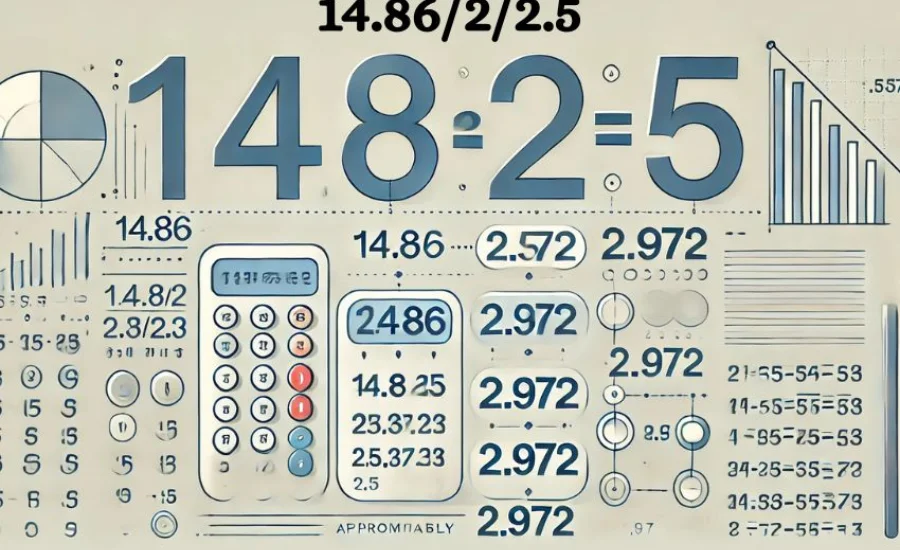14.86/2/2.5 mean? This article dives deep into the math behind it. At first glance, it may seem like a straightforward division, but there’s more to consider. Whether you’re dividing numbers in relation to finances, physical items, or any measurable quantity, understanding the calculation is essential for various real-life applications. Here at Scroll Blogs, our goal is to simplify complex topics, and this division problem is no different. By the end of this discussion, you’ll clearly understand what “14.86/2/2.5” signifies and how you can apply it in practical situations.
Breaking Down 14.86/2/2.5: Understanding the Process
The expression “14.86/2/2.5” involves two consecutive division steps. First, you divide 14.86 by 2, which gives 7.43. Then, you take this result and divide it by 2.5, resulting in approximately 2.972. While the calculation itself seems straightforward, the true value of this expression lies in how it’s applied. Whether you’re working with financial figures, distributing items, or dealing with other practical matters, the context of this division plays a critical role in interpreting its significance.
Applying 14.86/2/2.5 in Real-Life Scenarios
Financial Division: Imagine you have $14.86 and want to share it between two individuals. Each person would receive $7.43. Now, if each of them needs to divide their portion into 2.5 smaller parts, each part would amount to roughly $2.97. This kind of division can be helpful in various financial situations, such as splitting bills or tips, where breaking down amounts into smaller, more precise shares is necessary.
Precision in Measurement: Consider a piece of fabric that is 14.86 meters long. Cutting it in half would result in two pieces, each 7.43 meters long. If you then need to divide these parts into 2.5 smaller sections, each section would be approximately 2.97 meters in length. Accurate measurement is crucial in industries like tailoring, construction, or carpentry, where exact divisions ensure precision in projects.
Scaling in Cooking: When adjusting a recipe, especially for fewer servings, dividing ingredients accurately is key. If you have 14.86 ounces of flour and need to split it in two, each portion would be 7.43 ounces. Should you further divide one of those portions into 2.5 smaller amounts for another dish, each would weigh about 2.97 ounces. This level of precision helps maintain the integrity of your recipe, ensuring proper proportions.
Practical Use of Ratios in Various Fields
Engineering Applications: In engineering, ratios are essential for calculating dimensions and material requirements, especially when scaling structures. Whether you’re increasing or decreasing the size of a project, ratios ensure that all components remain proportionate, maintaining the integrity of the design.
Finance and Investments: Ratios play a critical role in finance, from analyzing returns to calculating interest rates and profit margins. A sequence like 14.86/2/2.5 could easily represent the breakdown of investment gains or the allocation of expenses over a certain period, making it easier to track financial progress and make informed decisions.
Scientific Precision: In science, ratios are vital for accurate measurements, particularly in experiments. They allow for precise comparisons between different quantities of substances, which is crucial for achieving the correct outcomes in chemical reactions or other scientific processes.
Understanding Ratios and Their Simplicity

A ratio compares two numbers to show how one quantity relates to another. It simplifies complex comparisons, making large or complicated numbers easier to manage and interpret.
Ratios break numbers into manageable parts, helping in various decision-making processes—whether for scaling a construction project, adjusting a recipe, or allocating a budget. They offer clarity and efficiency in handling tasks that require precision.
The Importance of Precision in Division
Whether you’re working with ingredients, finances, or measurements, accuracy is essential. While rounding to whole numbers might be acceptable in some situations, there are many cases—such as financial transactions or scientific experiments—where even minor rounding errors can lead to significant issues. For example, the result of “14.86/2/2.5” as 2.972 highlights the need for precision. Tools like calculators or Excel are invaluable for performing accurate division and avoiding costly mistakes.
At Scroll Blogs, we stress that Mathematical Sciences is crucial, whether for everyday tasks or advanced scientific calculations.
Solving 14.86/2/2.5: Different Approaches
Method 1: Step-by-Step Division
One common approach is sequential division. First, divide 14.86 by 2, resulting in 7.43. Then, divide 7.43 by 2.5, giving the final answer of 2.972. This method ensures accuracy by breaking the process into smaller, more manageable steps.
Method 2: Fractional Approach
Alternatively, the expression can be viewed as a fraction. Rewriting it as (14.86 ÷ 2) ÷ 2.5 simplifies to (14.86 ÷ 5), which also results in 2.972. This method provides a different perspective and can sometimes streamline the calculation process.
Applying 14.86/2/2.5 in Data Processing
In programming and data management, division operations like 14.86/2/2.5 are essential for tasks such as data distribution or load balancing. Imagine handling a dataset of 14.86 million records that needs to be processed by two servers. Each server would manage 7.43 million records. Dividing this further into 2.5 subprocesses per server means each subprocess would handle around 2.972 million records, showcasing how this calculation can optimize computing resources.
Key Insights on 14.86/2/2.5
- Mathematically, the result simplifies to approximately 2.972.
- This expression has practical applications across diverse fields like finance, cooking, construction, and data processing.
- Precision is vital, particularly in areas requiring high accuracy.
At Scroll Blogs, we strive to offer thorough, insightful content on such topics. Whether tackling everyday math challenges or complex computations, understanding fundamental concepts is key to success.
Practical Use of Ratios in Engineering, Finance, and Data
Engineers often rely on ratios to calculate key factors like load capacity and material strength. The ratio 14.86/2/2.5 can be adapted for these technical calculations, ensuring accurate and balanced results.
Budgeting and Financial Planning
In finance, dividing a total amount into smaller parts aids in distributing funds across different areas. This method helps in making sound investment decisions and financial projections for future growth.
Data Analysis and Statistics
Statisticians use ratios to analyze and interpret data. A ratio like 14.86/2/2.5 could be useful in comparing quantities within a dataset or understanding its distribution, leading to more accurate insights.
The Power of Ratios in Data Simplification

Ratios are essential tools that allow us to simplify complex data that might otherwise be challenging to analyze and interpret. By transforming large sets of information into more digestible parts, ratios make it easier to understand relationships between different quantities. Whether we’re dealing with small projects or large-scale operations, the use of ratios enhances our ability to make sense of various data points, facilitating better decision-making and resource allocation.
In engineering, for example, ratios help professionals assess load capacities and material strengths, ensuring that designs are safe and effective. In financial contexts, ratios allow businesses to break down expenses, revenues, and profit margins into meaningful insights, making it easier to identify trends and areas for improvement. The versatility of ratios makes them invaluable across multiple fields, as they can be adapted to fit various analytical needs.
Boosting Problem-Solving Skills
Beyond their application in data simplification, mastering ratios significantly enhances logical thinking and problem-solving skills. When individuals learn to work with ratios, they develop a framework for analyzing situations systematically. This skill set is particularly beneficial in areas such as financial management, where making informed decisions can directly impact a company’s bottom line.
In engineering, being adept at ratios enables engineers to create efficient solutions that balance cost, performance, and safety. Moreover, the ability to manipulate and understand ratios can aid individuals in tackling everyday challenges, from budgeting household expenses to planning events.
Ultimately, the proficiency in using ratios empowers individuals to approach problems with confidence and clarity, leading to better outcomes in both professional and personal contexts. As we continue to navigate increasingly complex data landscapes, the ability to simplify and analyze information through ratios will remain a crucial skill.
Also Read: 792.50-550
Final Words
The expression “14.86/2/2.5” represents a mathematical operation that can be applied in various real-world scenarios. When you divide 14.86 by 2, you get 7.43, which can illustrate how to share resources equally, such as splitting expenses or distributing materials in a project. Further dividing this result by 2.5 gives approximately 2.972, allowing for even finer divisions. This could be relevant in contexts like budgeting, where precise allocations are crucial, or in engineering, where material strengths need to be calculated accurately. Understanding and applying such ratios is vital, as it enhances decision-making and resource management across different fields. Whether in finance, data analysis, or everyday life, mastering expressions like “14.86/2/2.5” helps individuals navigate complex situations with greater ease and efficiency. Emphasizing precision in these calculations ensures that outcomes are reliable, making a significant impact on overall success in various endeavors.
FAQs
What does the expression 14.86/2/2.5 mean?
The expression represents two successive division operations: first dividing 14.86 by 2, then taking that result and dividing it by 2.5.
What is the result of 14.86/2/2.5?
The final result of the expression is approximately 2.972.
How do you calculate 14.86/2/2.5 step by step?
First, divide 14.86 by 2 to get 7.43. Then, divide 7.43 by 2.5 to arrive at approximately 2.972.
What practical applications does this expression have?
This expression can be used in various fields, including finance for budgeting, engineering for material calculations, and cooking for scaling recipes.
Why is precision important when calculating 14.86/2/2.5?
Precision is crucial in ensuring accurate results, especially in fields that require exact measurements, like finance and engineering.
Can I round the result of 14.86/2/2.5?
While you can round the result, it’s advisable to maintain accuracy for critical applications. The exact result is approximately 2.972.
How can I use 14.86/2/2.5 in budgeting?
You can use this expression to divide a total budget of 14.86 into two main categories and then further allocate funds into smaller parts.
Is 14.86/2/2.5 used in data analysis?
Yes, ratios like this can help in analyzing datasets by allowing for comparisons and distributions of values within the data.
What tools can I use to calculate 14.86/2/2.5 accurately?
You can use calculators, spreadsheet software like Excel, or even programming languages to ensure precise calculations.
How can understanding this expression enhance my problem-solving skills?
Mastering division expressions like 14.86/2/2.5 improves logical thinking and aids in breaking down complex problems into simpler components.
For more information and updates join us on Alevemente.




